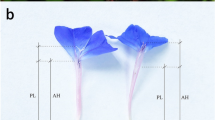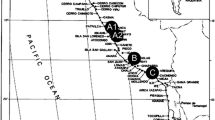Summary
Retention of pollen grains following natural self-pollination was evaluated in 15 cultivars (cvs.) of almond, 4 peach and 2 nectarine cvs., and 37 interspecific peach × almond hybrids compared to 7 almond seedlings. The level of pollen retention was presumed to reflect and integrate the degree of homogamy, the amount of pollen produced by the flower, the extent of anther-stigma contact during anthesis, and the level of pollen germination. Pollen retention averaged 5 times greater in the peach and nectarine cvs. than in the almond cvs. The greater pollen retention, characteristic of the peach, was dominant in expression in the interspecific F1 hybrids over the lower levels of pollen retention, characteristic of the almond. Thus, gametophytic self-incompatibility is not the only trait supporting outcrossing in the almond. Our data are consistent with the concept of co-evolution of floral traits relating to different breeding strategies. The level of pollen retention could often be anticipated at anthesis on the basis of blossom phenotype. That is, stigma-anther contact was observed frequently in the blossoms of peach, nectarine, and the peach × almond F1 hybrids, but only infrequently in almond.
Similar content being viewed by others
References
Armstrong, D. L., 1957. A cytogenetic study of some derivatives of the F1 hybrid Prunus amygdalus Batsch × P. persica L. Ph.D. dissertation, Univ. of Calif., Davis.
Brooks, R. M. & H. P., Olmo, 1972. Register of new fruit and nut varieties. Second Edition. University of California Press, Berkeley.
Detjen, L. R., 1944. Fruitfulness in peaches and its relationship to morphology and physiology of pollen grains. Univ. Del. Agr. Expt. Sta. Bull. No. 257, 24 p.
Heslop-Harrison, J., 1983. Self-incompatibility: phenomenology and physiology. Proc. Roy. Soc. Lond. B. 218: 371–395.
Hesse, C. O., 1975. Peaches. In: J., Janick & J. N., Moore (Eds) Advances in fruit breeding. Purdue University Press, West Lafayette, Indiana, pp. 285–335.
Kester, D. E. & R., Asay, 1975. Almond. In: J., Janick & J. N., Moore (Eds). Advances in fruit breeding. Purdue University Press, West Lafayette, Indiana, pp. 387–419.
Kester, D. E. & W. H., Griggs, 1959. Fruit setting in the almond: The pattern of flower and fruit drop. Proc. Amer. Soc. Hort. Sci. 74: 214–219.
Langridge, D. F. & R. D., Goodman, 1979. Pollination of canning peaches cultivar Golden Queen. Aust. J. Exp. Agr. Ani. Husb. 19: 510–512.
Langridge, D. F., P. T., Jenkins & R. D., Goodman. 1977. A study on pollination of dessert peaches cultivar Crawford. Aust. J. Exp. Agr. Ani. Husb. 17: 697–699.
McGregor, S. E., 1976a. Almond. In: Insect pollination of cultivated crop plants. USDA Handbook No. 496. Agr. Res. Ser., pp. 75–79.
McGregor, S. E., 1976b. Peach and nectarine. In: Insect pollination of cutivated crop plants. USDA Handbook No. 496, Agr. Res. Ser., pp. 281–285.
Pimienta, E. & V. S., Polito, 1983. Embryo sac development in almond [Prunus dulcis (Mill.) D. A. Webb] as affected by cross-, self- and non-pollination. Ann. Bot. 51: 469–479.
Pimienta, E., V. S., Polito & D. E., Kester, 1983. Pollen tube growth in cross- and self-pollinated ‘Nonpareil’ almond. J. Amer. Soc. Hort. Sci. 108: 643–647.
Rick, C. M., 1982. Genetic relationships between self-incompatibility and floral traits in the tomato species. Bio. Zbl. 101: 185–198.
Socias I Company, R., D. E., Kester & M. V., Bradley, 1976. Effects of temperature and genotype on pollen tube growth in some self-incompatible and self-compatible almond cultivars. J. Amer. Soc. Hort. Sci. 101: 490–493.
Watkins, R, 1976. Cherry, plum, peach, apricot, and almond. In: N. W., Simmons (Ed.), Evolution of crop plants. Longman, New York, pp. 242–247.
Weinbaum, S. A. Role of natural self pollination in self-fruitfulness of almond. Sci. Hort. (in press).
Weinbaum, S. A. & A., Erez, 1983. Autogamy among selected peach and nectarine cultivars. Fruit Var. J. 37: 113–114.
Weinbaum, S. A. & V. S. Polito, Development of a convenient assay based on autofluorescence of the exine of the pollen grain wall. Mikroskopie (in press).
Author information
Authors and Affiliations
Rights and permissions
About this article
Cite this article
Weinbaum, S.A., Polito, V.S. & Kester, D.E. Pollen retention following natural self pollination in peach, almond, and peach × almond hybrids. Euphytica 35, 193–200 (1986). https://doi.org/10.1007/BF00028557
Received:
Issue Date:
DOI: https://doi.org/10.1007/BF00028557




